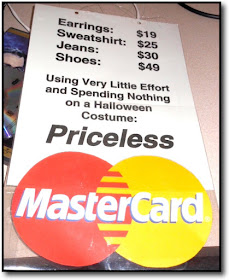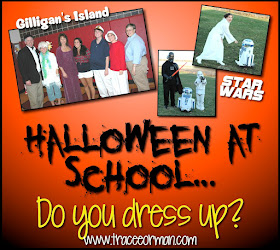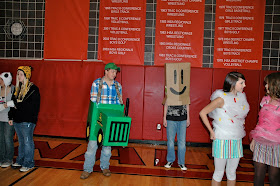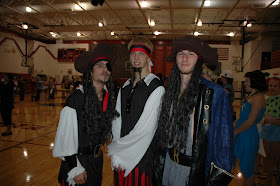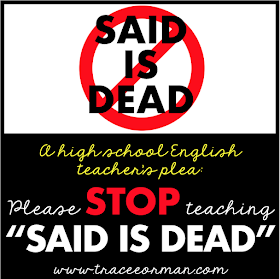And if you just don't feel like making a costume, here's an idea for a pretty easy one to make: Create a MasterCard "Priceless" sign and wear it around your neck. I wore this one a few years ago:
Resources, activities, and lessons from a high school English/Language Arts Teacher.
▼
More Halloween Costumes!
Halloween at the High School - Do You Dress Up?
It's almost Halloween and I haven't started on my Halloween costume yet...in fact, I'm kind of a procrastinator when it comes to that, then find myself frantically pulling something together the night before. But, I must say, our teaching staff has been pretty darn good about sporting some cool costumes over the years.
Do you dress up at school? Do your students? Do you celebrate at all? I thought I would share some of our best (and maybe worst) costumes over the years...those I have pictures of, anyway. And to fill you in: my husband teaches at the same school, which is why we are often photographed together. ;]
Our school has contests each year for best group, best couple, best individual, scariest, most creative, etc. The faculty doesn't compete against the students, but we still like to have fun and participate. A couple of years ago we went as Gilligan's Island (I'm Lovey Howell...with my Andy Warhol wig.)
The Village People (they even had a dance!)
My husband was Darth Vader and I went as Princess Leia's hologram that is projected from R2D2. (So my only line all day was, "Help me, Obi Wan Kenobi. You're my only hope!") I made my R2D2 with a popcorn bowl taped to a trash can on top of an ab roller. I stuck a flashlight inbetween the bowl & trash can so it looked like I was the hologram. I fashioned fishing line from the ab roller to my boot, so when I walked, R2D2 rolled with me. The students could not figure out how I got him to roll. ;)
Our son went as a Stormtrooper that year, so it was pretty cool when the elementary kids came over and did their parade at the high school. We forgot to get a group shot together, though. :(
Stephen King's Carrie.
Members of the Lollipop Guild with a fireman.
Our special ed. teachers always have the best group costumes! (They organized the Gilligan's Island and this Lollipop Guild. Last year they did Charlie Brown. Another year was the Adams Family.)
Our art teacher is always creative, too. Here he is as Snoopy. Below, he's Buzz Lightyear.
My husband and I as King Tut and Sister Wendy. Yes, we are geeked out to the max!
And this was going to be my costume one year. I was supposed to cut out the eyes and go as the "Scream" painting by Munch (this was when I was also teaching art history). But I was so proud of my painting, I just couldn't cut the eyes. lol So I went as Princess Leia's hologram that year.
If I can find the picture of me as a PEZ dispenser, I will add it. That was definitely a challenging costume to get around in all day!
Here are some of my favorite student costumes over the last few years.
This one I am biased--it's our son as Mr. Bill. :) The crayons behind him are awesome, too.
Rock, Paper, Scissors...
Tractor and paper sack guy.
Tooth fairy.
Taco Sauce Packets.
Jelly Belly jelly beans.
Fruit of the Loom.
Ken and Barbie in their Dream Car.
Girl Scout & Boy Scout.
Miscellaneous class group picture.
And who doesn't love a pirate? Arrrrgh!
The Flintstones.
Bella and Edward (or, Edward's cut-out).
Will you dress up this year? If so, tell us as what you will be.
And post your links to your Halloween costumes below! :)
HAPPY HALLOWEEN!
Writing a Literary Analysis Paper--TED to the Rescue
If your students are writing a literary analysis paper, this TED video is definitely worth viewing. I was happy to see that it encourages students to write the introduction LAST (otherwise students get stuck on writing that first sentence and take days to move on). It also encourages them to get more creative with their hooks--stop using a rhetorical question or a quote; neither is going to draw the reader in.
In all, it's excellent advice and the video uses captivating animation to clearly model a good introduction for a literary analysis. Check it out yourself:
Thanks to http://hawkinsanity.blogspot.com for the tip!
The Difference Between PNG and JPG Image Files
When I was going to school to be a journalist in the early 90s, we didn't learn about digital files. In fact, I took an old-school photography class complete with darkroom developing. My, how times have changed. That said, I had to learn the terminology pretty quickly when I became a journalism teacher and a yearbook and newspaper adviser. The hands-on learning and trial-by-error experience taught me more than any college class could.
One of the most common questions I get is, "What is the difference between a jpeg and other image files?" Here is a condensed explanation to the difference between PNG and JPG files from a previous summer post found here:
The PNG format makes it possible to knock-out the background (or make it transparent), so your images easily layer on top of one another without the white (or whatever color) background overlapping. You cannot layer JPG (or jpeg) files like this.
To demonstrate, see the image below. The girl on the left is a JPG file and the girl on the right in a PNG file. When each is placed on a purplish background, the JPG file will maintain its white background. The PNG's is knocked-out, allowing you to place additional PNG files on top of it.

Another difference between the two is PNG files never lose their quality. JPGs, however, will begin to degrade every time you open them, so over time the quality of the image will not be as sharp. Because of this, PNG files are much larger than JPGs, making JPGs (and GIFs) more ideal for web browsing because they load faster.
I've picked up a lot from teaching journalism and continue to learn as technology keeps advancing. That's an advantage to teaching: it forces us to keep learning and passing along that knowledge. Of course, I learn just as much from my students as they learn from me.
I've picked up a lot from teaching journalism and continue to learn as technology keeps advancing. That's an advantage to teaching: it forces us to keep learning and passing along that knowledge. Of course, I learn just as much from my students as they learn from me.
If you need help working with images in Microsoft Word (which, in my opinion, is one of the worst programs for design/working with images), you can download this free tutorial. People who use Microsoft and do a lot of designing would probably be better off using Powerpoint or Publisher.
Since I am a Mac girl, I use the iWork applications (Pages, Keynote) and Adobe's Creative Suites apps: Photoshop and InDesign. Pages is much like InDesign, but much easier, so I have actually converted to using Pages more. If you use a Mac, I highly recommend it!
An English Teacher's Plea to Keep "Said" Alive
You've probably seen the pictures on Pinterest proclaiming that "Said is Dead!" with columns of alternative attributions to use for more descriptive writing. I've never understood this. "Said" serves a useful purpose in writing and quoting dialogue.
I wondered why students were being taught not to use it? This certainly was not anything I had learned in any of my writing courses.
I was informed that students are encouraged to use alternatives to make their writing more descriptive. "Show, don't tell!" Hmmm... I encourage my students to "show, don't tell" as well, but I've never focused on the attribution.
Should I? Does it really enhance your writing by using alternative synonyms?
I don't think it does. In fact, I think it can make your writing worse.
I know this may upset many teachers out there who insist that getting rid of "said" makes for better writing, so here are my reasons why you should keep "said" alive:
1. Expository/Informative writing must be unbiased, therefore using anything but "said" would be creating a connotation or bias. This is my #1 problem with "said is dead." Many of my journalism students will want to use other words beside "said" (or "says") in their articles. This is a big no-no in journalism.
Look at the front page of a newspaper and read any of the latest news stories. For every quote the writer will use "said" or "says." (See example, below.) It would be unethical for the writer of a news story to create bias by using words like "demanded," "argued," "gloated," or "whined." If you do see these words in a "news" story, I wouldn't trust the writer or the publication. This is a technique that pundits will use to twist or distort a quote to promote their own opinion. It's also the quickest way to see if a news source is reliable and unbiased: if their writers or newscasters use attributions other than "said," then they are, indeed, biased. It is wrong for someone claiming to be a journalist--whether in print or broadcast--to use biased terminology when reporting the news.
2. "Said," like any other word, shouldn't be overused; but that doesn't mean it should be replaced. If you find yourself overusing the word "said," instead of replacing it with other words, see if it is even needed at all. For example, author Suzanne Collins demonstrates in The Hunger Games the technique (or rule?) of starting a new paragraph with each new speaker. While in some cases it may be necessary to attribute the quote to a certain speaker, in many cases an attribution can be left off:
 |
| An example when attribution is not necessary in lines of dialogue. |
3. If your line of dialogue needs improving, changing the attribution isn't the answer. Your quotes should speak for themselves. Getting creative with synonyms for said will not make the dialogue better. In fact, it will probably distract the reader. Try improving the actual dialogue, not the attribution:
4. There's a reason why "said" works in writing: we tend to skip over the word when we're reading it. And that's OK! That is what makes the piece flow. If we begin to muck-up our writing with alternatives to "said," it disrupts that natural flow.
It IS OK to use alternatives to "said" with younger students.
Many children's books will use creative attributions in dialogue, and that's fine. The audience for those works are children who have very short attention spans and crave dramatic effects; using "exclaimed" and "growled" and "whimpered" will work perfectly for that audience. But unless you are having your students only write for their peers aged 2-8, please do their future English teachers a favor and keep "said" alive. Thank you.
The Best Banned Books Pinterest PinBoards
 |
| Top Banned Books Boards on Pinterest |
To conclude the celebration for Banned Books Week, I'd like to share my top 5 (or more...) favorite Banned Books Pinterest pinboards. These boards contain a variety of memes, inspirational quotes, activities, videos, and books that have all been challenged or banned.
1. Already mentioned on my list of Top 5 Book Boards but worth another shout-out is Banned Books by Random House (Collaborative board)
2. Banned Books Week by Somers Library
3. Banned Books Week Pinterest User
4. Banned, Challenged, Censored, & Censured by Missoula Public Library
5. Banned Books Week by RH Library (Collaborative board)
6. (Yes, I went over 5!) Librarian Files: Banned Books Week by Regina Townsend - Great display examples for Banned Books Week!
What I love about these banned books boards is that they not only offer an excellent reading list for college-bound students, but they feature some of the best literary quotes from our favorite authors. You can find several book-related pinboards on my Pinterest page: Mrs. Orman's Pinterest Pinboards
Pinterest is full of amazing book pinners and boards that can give your students great reading suggestions when they are looking for a new book. There are so many libraries that are now pinning new books and library activity suggestions. One of my favorite boards to follow for librarians is the Teen Programming in Libraries (a collaborative board) by Heather Booth. Librarians are definitely an English teacher's best friend. (Plus, I was a K-12 librarian at a private school before I started teaching English and journalism, so I'm a little biased!)
To wrap up this post, I'd like to let you all know about a great giveaway Creation Castle is having for Banned Books Week: teaching resources based on literature at every grade level. Make sure to enter to win today! It ends at midnight tonight. P.S. High school teachers: You have an excellent chance to win since there are only 78 entries as of 9 a.m. this morning. I donated my To Kill a Mockingbird Teaching Unit and for the middle school giveaway, my Hunger Games Student Survival Pack & Teacher's Guide. Don't miss out on winning those & other great literature resources! {ENTER HERE}





